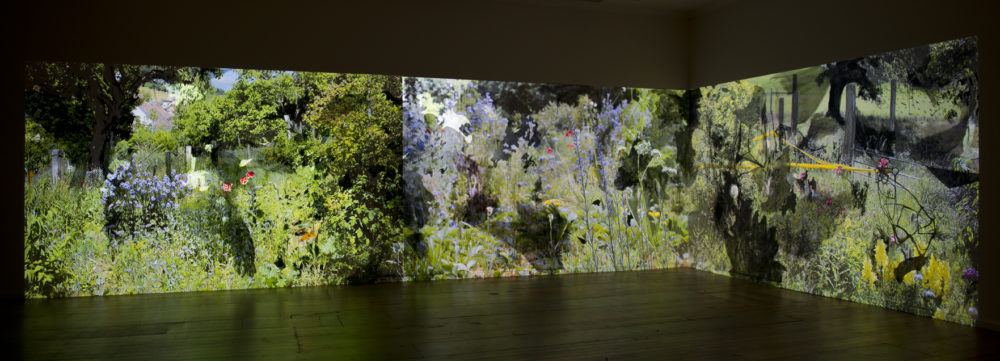
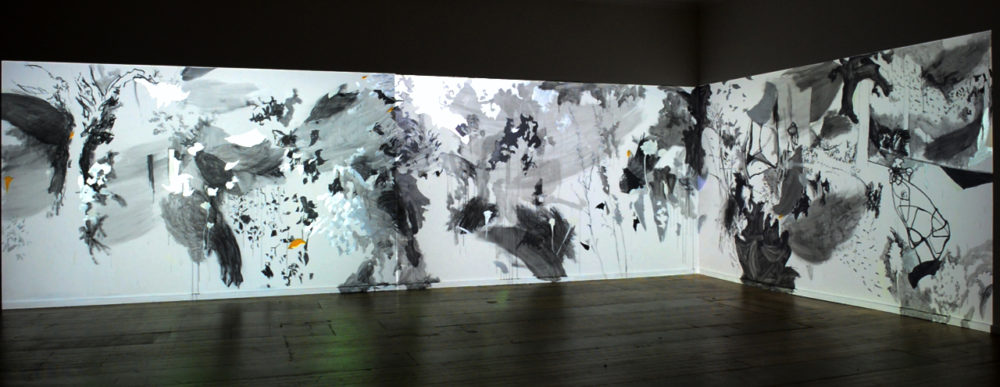
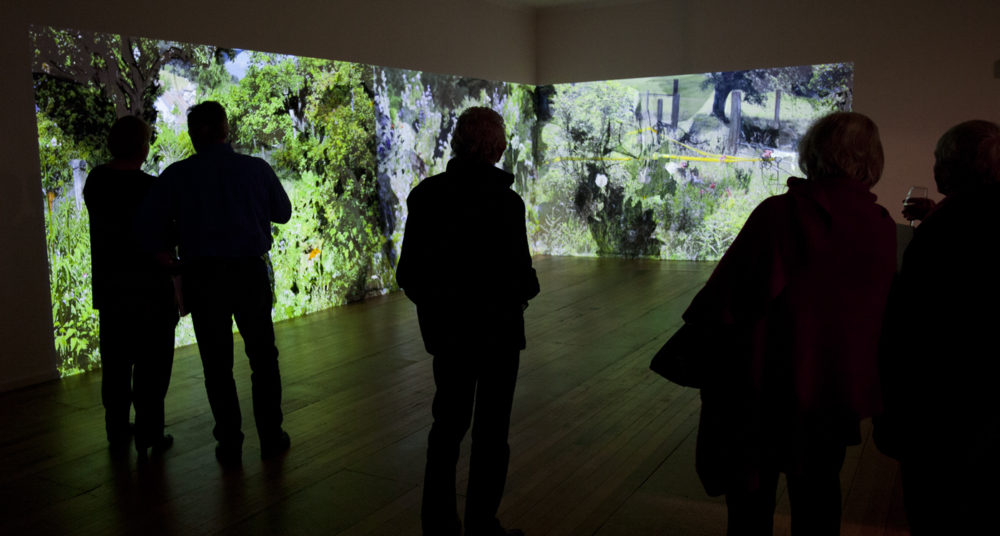
Formal : Informal (Tremezzo) the spatiality of a Swiss veggie patch.
ADFA Contemporary Art Space, Mildura, Australia, 2014.
“It doesn’t matter what size we are when we nudge the surface: we may be gigantic or small – all that matters is how far we have come through the rock […] We have no words for this darkness. From time to time we all come across this darkness, seeing everything: so much everything, that we can distinguish nothing. It is not night and it is not ignorance, it’s the extension from which everything came.” [1]
– John Berger
Formal : Informal (Tremezzo) the spatiality of a Swiss veggie patch (2014), articulates a particular intercultural ‘spatiality’ that is not readily visible. An immersive spatiality that is neither Original nor Appropriated, Landscape nor Country, Formal nor Informal.
This project follows on from two earlier projects titled, Tremezzo (Hobart, 2013) and Worlds End Highway (Helsinki, 2014). Both employed similar attempts at articulating such spatiality.
Tremezzo is a small town on Lake Como in northern Italy. This project began there following one of my journeys to research what are possibly the oldest known maps in Europe – amongst 300,000 rock engravings in nearby Valcamonica. In Italian, ‘tremezzo’ loosely translates as ‘three and a half’. 3½ minutes has become the worldwide average attention span given to say, a contemporary song, or to a you-tube video. It also happens to be approximately the longest amount of time that most people can hold their breath. This project works with the notion that contemporaneity in the information age is inherently transcultural and that a 3½ minute moment of intuitive resonance exists immediately following any cultural experience. Therefore a resonant intercultural ‘afterimage’ might also become visible within the spatiality of this moment. Our lives are made up of a perpetual series of afterimages, which we presume we are unable to revisit.
Formal : Informal (Tremezzo) the spatiality of a Swiss veggie patch (2014) examines the idea that such an ‘afterimage’ might be capable of being revisited, or realised as a continuum – repeated as a looped installation, offering new and extended portals of intercultural insight.
The 3.5m x 15m charcoal drawing was made directly onto the gallery wall in concert with a video projection, alternating variously between 3½ minute views of a Swiss veggie patch and 3½ minutes of pixelated white light. The drawing was made both, during the video projection and as an ‘afterimage’ (drawn from memory) during the periods of white light, over 3½ days.
The spatiality that became visible as the projection of the garden interacted with the wall drawing was dynamic – the wall drawing itself alternately appearing to hover off the wall and be projected onto the wall. What appears to be an optical illusion depending on the light and movement of the video, is I suggest, such spatiality made visible.
An ‘afterimage’ is usually considered to be the ephemeral, hovering, often inconsequential, remnant of ocular vision that remains in the minds-eye for a few moments after one looks away. In this ongoing series however, I’m interested in the idea that afterimages might also exist within the spatiality of cultural difference and be capable of re-illuminating lost intercultural knowledge, or as Berger says, the ‘darkness from which everything came’.
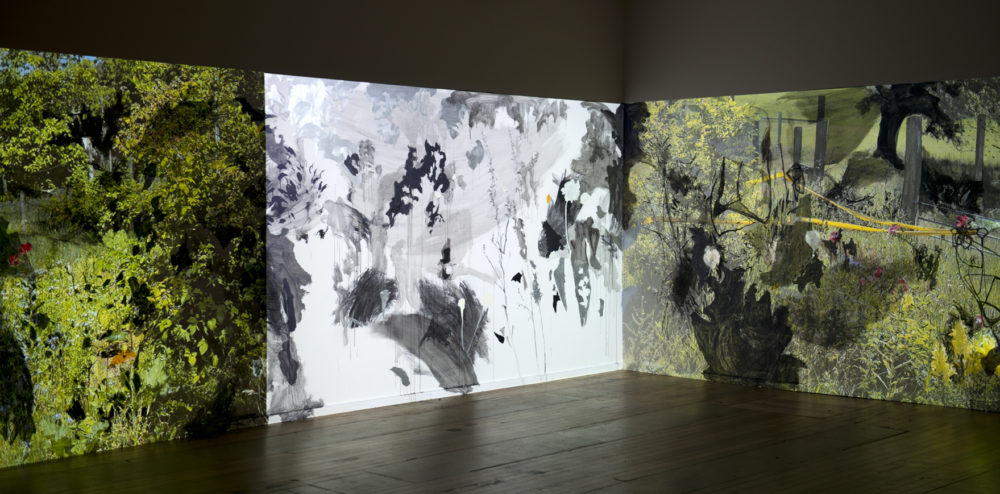
In this work, neither the videos, nor the drawings are the originals. As such, the work suggests that juxtaposition of any kind, be it cultural, curatorial, physical collage, or some other relational materiality, is in danger of being a product of inactive, ‘easy’ definition; of dichotomy devoid of experiential spatiality. It questions the persitstent conflation of global modern ‘in-between’ space. Curiously however, whichever way it is perceived, this spatiality is unable to be fully documented or conveyed by secondary media. It must be experienced.
My working travels in northern Italy, researching originary rock engravings, have led me to thinking anew about European cultural origins. Recently I stayed with good friends for a few days in Switzerland, where the nourishment of their calm and creative world, their conviviality, wonderful hospitality and above all their idyllic veggie garden, became the focus of my work. It became clear to me that the inherent spatial ‘darkness’ that John Berger so eloquently describes (above), resides somewhere in the spatiality that breathes between cultures, like an emulsion. And that this has always been contemporary. Being confronted by one’s own cultural idyll can be instructive.
Berger writes, “We all come across this darkness, seeing everything: so much everything, that we can distinguish nothing.” And this is, if not at first glance, the perfect descriprtor for the vast cultural difference between a veggie patch in Switzerland and one in Australia. Such veggie gardens come from this same conceptual origin. Yet, such an idyllic ‘landscape’ creates an entirely different cultural and spatial resonance in Australia than in Europe.
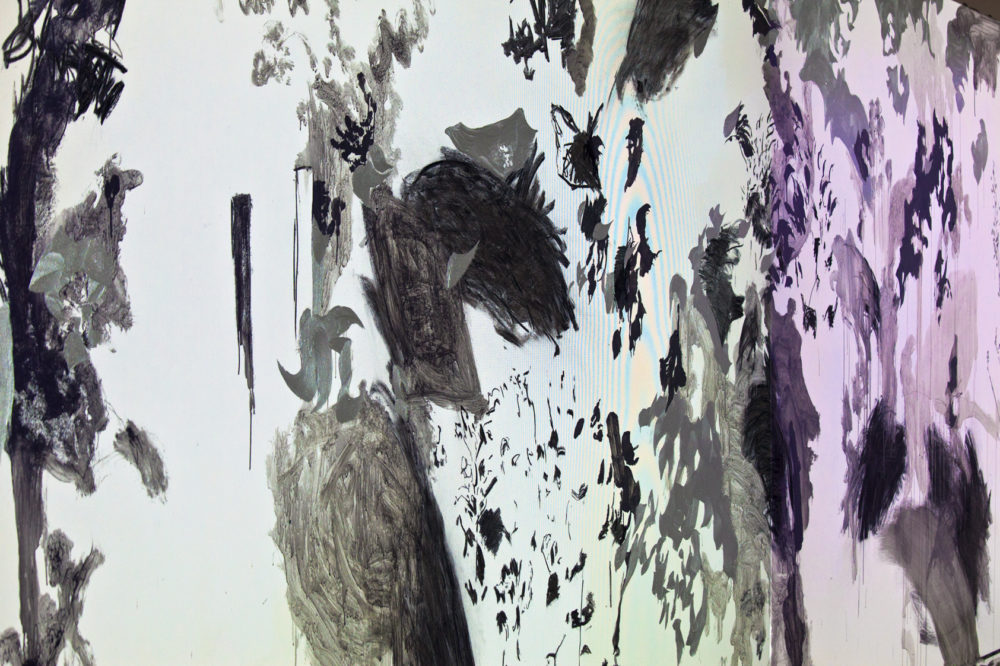
In contrast, my working life across Australia over the past 20 years has absolutely clarified for me, the destructive cultural spatiality that neo-colonial conceptions of idyllic ‘landscapes’ continue to so uncomfortably deploy here. I’ve seen that this particular inner darkness is a spatiality of fear and doubt that manifests in wilful denial of the plain fact that Australia has always been a multi-nation Aboriginal continent, full of all manner of veggie gardens. The neo-colonial imaginary about a great southland paradise since medieval times continues, absolutely convinced it is ‘seeing everything: so much everything.’ And yet, the intercultural spatiality that makes it so rich remains largely unseen.
Between 5,000 and 13,000 years ago in northern Italy glaciated granite was the media ‘screen’ of choice on which rock engraving emerged as the interactive and experiential art-form of its time; it’s power and potential remaining undiminished today. Ever since however, the delimiting nature of contemporary ‘landscape’ (empirical/archaeological/idylic) continues to de-value a fuller interaction with the ‘inner-darkness’ of the rock. Some say the incisioni (engravings) themselves are a way back into the rock. For me this complex ‘inner-darkness’ is visible right in front of me.
When the Romans invaded what was to become northern Italy, the indigenous Camuni people had already been creating veggie gardens as well as some of the worlds most exquisite rock engravings, which continue today to map and conceal their complex and contrary knowledge of Camuni country. It was the arrival of the Roman ‘landscaping’ forces from the south that brought irrevocable change to the valleys. They destroyed, overlaid and caused the significant loss of earlier in-depth conceptions of religion, belief and artistic knowledge.
The Tremezzo project (ongoing since 2012) doesn’t yet reference rock art directly. Rather it is the contemporary delimiting nature of the landscape paradigm that I’m deliberately pushing back against in this series. Indirectly, the influence of Italian rock art in developing my video-wall-drawing process and my awareness of the specific spatiality I describe is akin to Berger’s ‘dark inner-light’. The landscape paradigm in this context is both a product of and a hinderance to seeing through this particular kind of darkness; but also necessary to address if ways of accessing spatiality between cultures, countries and within myself is to be reconciled.
Working with spatiality in this way has always been an entirely different vocation to working with ‘space’. This of course is why Italian artist Lucio Fontana called his visionary opus, ‘Concetto Spaziale’ (Spatial Concept); as distinct from space concept, or negative space concept. The Tremezzo project pushes Fontana’s ‘spatial concept’ further, attempting to make visible a more immersive-ever-present spatiality.
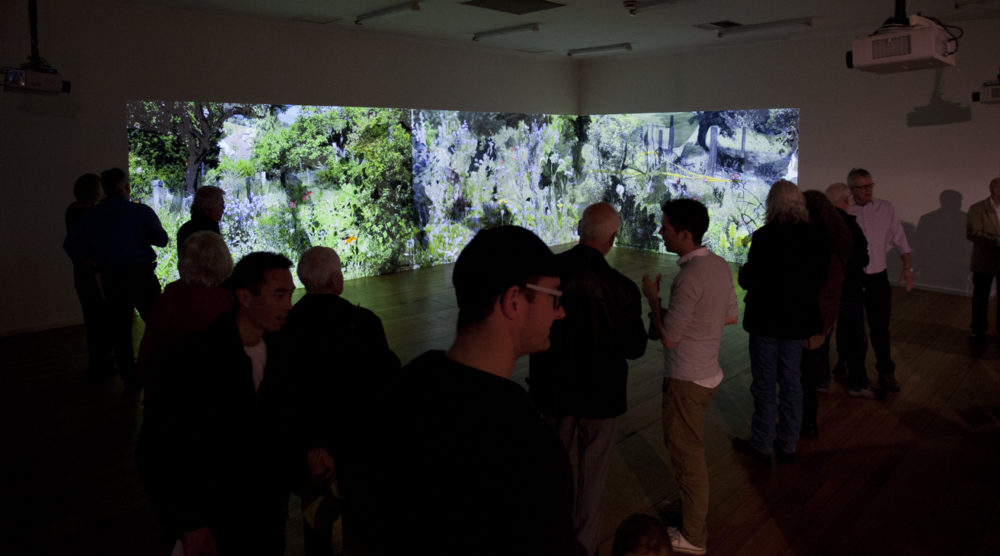
While ‘art informel’ has long been perceived as the antidote to ‘formalism’s’ rejection of notions of specific cultural authorship, the redundant formal-informal dichotomy remains somehow at the heart of intercultural discord in contemporary art. Christine Ross recently and rather uninspiringly concluded that “If contemporary art is to challenge the modern regime of historicity, it does so by instituting interminability as the most pivotal feature of historical time.”[2] However, global intercultural spatiality is more interactive, experiential and ever-present in far more complex ways that are quite distinct from what might otherwise be imagined, or mistaken, as some kind of ‘new’ or ‘between space’ mediated by interminable neo-modernism. Rather, the potential spatiality of contemporaneity is simultaneously ‘virtual and grounded’, extending way beyond the mere surface frisson of historical time.
By seeking to make expanded, durational spatiality visible in the apparent everydayness between video and wall drawing, this work also attempts to stretch conceptions of the authorship of such spatiality. In this way the work is also asking: what is the difference between an ‘afterimage’ and an appropriation? Is the video an original or an appropriation; or is it the afterimage? Does drawing from the video appropriate and hence play the reductionist westernizing role of landscape? Or do the two afterimages combine – to make another kind of spatiality visible in the discussion? Are they both by virtue of their re-framing within a screen, a room, a wall, reduced to landscape? Or could it be that such afterimages maintain the capacity to reveal previously unseen intercultural connectivity? Is this spatiality a way of seeing further into the ‘darkness that is not ignorance’; the ‘spatial concept’ of intercultural contemporaneity?
Formal : Informal (Tremezzo) the spatiality of a Swiss veggie patch (2014). The video component of the work was made in Lagenbruck, Switzerland in June 2014. The full experiential project was a performative installation in Mildura, Australia, whereby the final wall drawing and projection work gradually become apparent over 3½ days (tremezzo) in the lead up to the opening on 6 September, 2014.
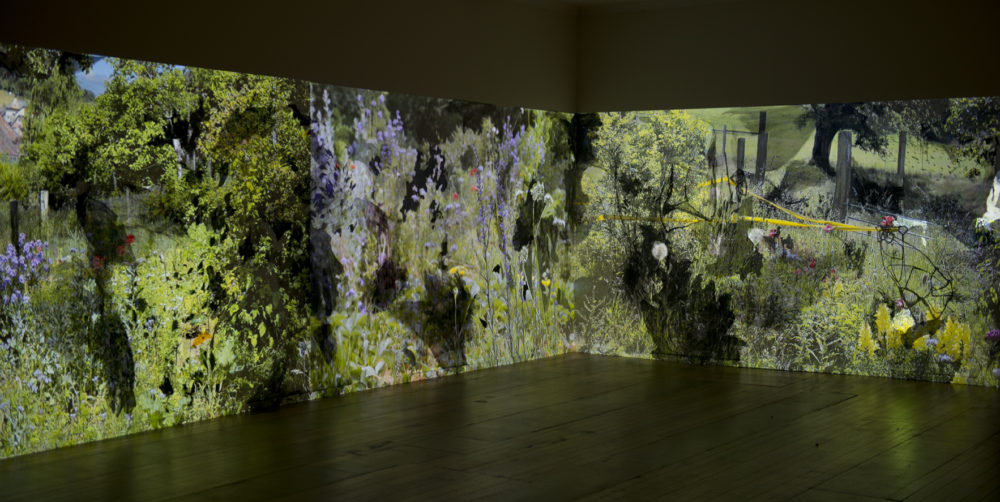
© Jonathan Kimberley 2014.
Special thanks to: Gerda Steiner & Jörg Lenzlinger in Switzerland, Ross Lake & Helen Vivian, Danielle Hanifin, Mildura Brewery.
[1] Berger, John, The Shape of a Pocket, Vintage International, Knopf Doubleday Publishing Group, 2009, p.37, 41-42. [NB: Berger describes his thinking in relation to the famous Chauvet Cave paintings, in France. However, my reinterpretation of Berger relates to rock engravings in Valcamonica, northern Italy and wall drawing as an ephemeral contemporary equivalent.]
[2] Ross, Christine, The Past is the Present; It’s the Future Too, The temporal turn in contemporary art, Bloomsbury Academic, New York, 2014, p.305